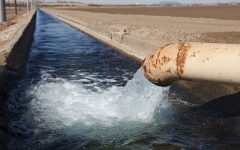
CA Water-saving tips. (Photo: drought.ca.gov)
California Takes the Lead in Regulating Microplastics in Drinking Water
Urban stormwater runoff is a pathway that carries plastic-laden trash to water bodies
By Thierry Montoya, November 11, 2023 2:45 am
The latest phase in California’s effort to limit microplastics in drinking water may cause legal battles over reportable limits, exposure data and human health effects. The State Water Resources Control Board (SWRCB) will test water supplies for microplastics over the next four years. The result will be SWRCB guidelines setting microplastic levels deemed safe to drink. This process is the outcome of California Senate Bill 1422, passed in 2018, which requires the SWRCB to establish standards for detecting and reporting microplastics in drinking water.
What Are Microplastics?
Microplastics are tiny plastic particles that are manufactured at a small scale or break apart from larger plastic items. Microplastics are everywhere in the environment, in oceans, rivers, soils, and even the air. Plastics can be harmful to the environment and human health as they accumulate in ecosystems, entering the food chain either by ingestion or by inhalation. There are ongoing studies to understand and mitigate their impact on the environment and human health.
Testing Process
In late 2023, the SWRCB will sample microplastics from 30 wastewater systems in California. Lab technicians will place water samples on slides for microscopic evaluation. Microplastic particles may not be prevalent across the entire slide sample, so a lab technician will divide a slide into quadrants for analysis, and then tally the total amount of microscopic plastic particles per slide.
The SWRCB has included major urban systems that provide water to cities like Los Angeles, Sacramento, and San Francisco in the sampling group. SWRCB sampling focuses on untreated source water that awaits treatment at wastewater facilities. The focus on source water is necessary as wastewater treatment systems are effective at removing the bulk of microplastic particles up to the smallest of plastic fibers which escape the treatment process.
Challenges Ahead
Water sampling for microplastics is challenging. Cross-contamination can happen if water samples touch plastic or airborne microplastics. A sampler must be a skilled filterer to separate plastic from other particles in turbid water.
Identifying microplastics’ size, shape, and composition is a challenge for current laboratory analysis tools. The size, shape, and composition of microplastics are hard to determine using microscopes that see to 20 microns.
In addition, human judgment is necessary to distinguish between separate plastics versus other non-plastic particles. Better technology is required to analyze microplastics accurately. Which is why Senate Bill 1422 requires the development of new technology to effectively detect microplastics.
The SWRCB will expand the second phase of testing to drinking water if technology detects the smallest plastic particles.
The goal of SWRCB is to collect test results to regulate microplastics as contaminants in drinking water. With that goal in mind, several business sectors may want to consider alternatives to petroleum-based plastics, synthetic microfiber products, or plastic-based mulch, i.e., single-use foodware packaging, textile and agricultural businesses.
Urban stormwater runoff is a pathway that carries plastic-laden trash to water bodies. The SWRCB requires select California businesses to have a stormwater prevention plan in place. Microplastic-related regulations may require stormwater plans to include management plans to reduce onsite trash, which includes plastics, from being swept up in storm flows.
The SWRCB may also impose microplastic monitoring and reporting obligations on regulated businesses via California Waste Discharge Requirements (WDR). Regulated businesses will then have to adhere to WDR-mandated cleanup obligations.
Next Steps for Regulated Industries
Regulated entities should now analyze whether their business operations release plastic particles into waters that are used for drinking water, groundwater included.
Microplastic regulations will also affect the wastewater industry. The wastewater industry releases treated water back into aquatic environments. The agricultural industry also uses sewage sludge as soil enhancement. Those are two potential routes for microplastic releases. The wastewater industry is effective in removing the bulk of microplastics but some of the tiniest particles survive treatment methods. Future microplastic regulation may require enhanced wastewater treatment methods.








Considering that everyone is living longer, maybe micro plastics are good for us. Here we see the beginning of a new industry that will soon be squeezing a billion or two dollars a year out of consumers by ripping out infrastructure and ordering it replaced with products with their own seal of approval.
Masks are a major source of micro plastics in your lungs. Funny how no one mentions Noisome’s billions spent on Chinese masks anymore.